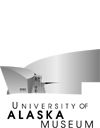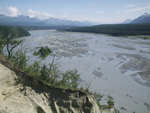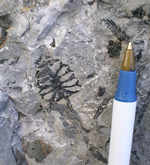
Trip Log: Wednesday, July 10, 2002
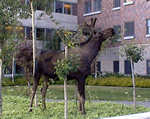 |
|
Above:Young moose greeting us at UAA. |
Today we began our drive up the Glenn Highway on our field trip to Fairbanks. As we began to pack the vans for the trip, we were greeted by a young velvet-antlered moose (top left) who was ripping the leaves off the newly planted aspen trees in front of North Hall, our home at UAA for the past two nights. (By the way, antlers fall off each year, but horns are permanent).
At our first stop we were treated to a breathtaking view of the glacier valley at the Matanuska overlook (below left) where we gazed at the braided Matanuska riverbed. Here, Dr. Anne Pasch, Professor Emeritus, Geology, taught us to identify glacial till, sand dunes, and loess.
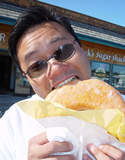 |
|
Above: Chris meets his match with an Alaskan-sized donut. |
On our way to the next stop at Wishbone Hill, we stopped at the “Purple Moose” for lattes and pastry. Chris bought an Alaskan-sized doughnut (right), too large to be consumed in one day.
At Wishbone Hill, we were introduced to the excitement of fossil hunting. This area is rich in plant fossils from the Paleocene age (55 million years ago), discovered when strip mining for coal here exposed the Chickaloon formation. We found many fossils of Metasequoia (below right), which look much like our California Coastal Redwood, and many Equisetum, (horsetails) which look much like our common horsetails of today.
That night, we camped at the Matanuska Overlook Campground. Rain did not dampen our enthusiasm at first sighting the glacier. Later that evening we visited Glacier View School (K–12!) and enjoyed meeting and talking with science teacher Garth Morgan, who is responsible for the entire K–12 science instruction. We were impressed with the school’s modern and well-equipped science lab.
Hoping our equipment was all the salespeople had promised, we climbed into our tents and sleeping bags, looking forward to the next day’s exploration of the glacier.
Reporters for the day: Pam and Peg
Back (July 9) | Next (July 11)

